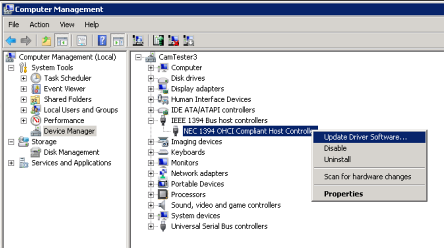
- #Windows 7 1394 legacy driver install
- #Windows 7 1394 legacy driver drivers
- #Windows 7 1394 legacy driver driver
- #Windows 7 1394 legacy driver code
Open device-manager and click on the arrow left to “IEEE 1394 Bug Host Controllers” to reveal the “Texas Instruments 1394 OHCI Compliant Host Controller”. They provide a step by step proceedure for changing to the legacy driver…found it…as follows… RME has a good writeup on their tech support pages (also mentioned in their user forums under their firewire devices)where they talk about using the Windows legacy firewire drivers. They tell me they run very nicely under windows7. I’ve spoken with a few folks on the Gearslutz forum who use the Focusrite firewire interfaces.
#Windows 7 1394 legacy driver driver
I would need to get a pci firewire card as i only have 1 firewire port so would i be able to set the legacy driver to one firewire port and the native win7 to another,
#Windows 7 1394 legacy driver drivers
So if this is true would an interface that was based on win7 native drivers still work with the legacy one.
#Windows 7 1394 legacy driver install
I know nothing about computers and drivers so this may sound stupid to some.įrom what i can tell you change to the legacy driver from the control panel so that would lead me to believe that when you install a driver from a product like the liquidmix or an interface then that driver would work based on the driver settings in the control panel (hope this makes sense) Would the legacy firewire affect the interface, So a potential new interface could and more than likly will be firewire, I may have to get a new interface also as emu dosnt have an official driver release ( we will wait and see about that). I have a focusrite liquidmix that should work with a legacy firewire driver which is fine BUT… The u member of the IRB contains the request-specific parameters, in a union of data structures, one per request type.ĭuring normal operation, drivers receive ordinary I/O requests (such as IRP_MJ_READ), convert them to the appropriate IEEE 1394 operation, and dispatch that operation to the device through IOCTL_1394_CLASS.Because of steinbergs lack of support for xp with cubase 6 im now thinking of getting windows 7. The IRB structure contains parameters that apply to each bus request and request-specific parameters. The bus driver uses the IOCTL_1394_CLASS IRP to present an interface to both the bus and the host controller. The FunctionNumber member of the IRB determines the type of operation, and the u member describes the operation. The driver packages the parameters in an IEEE 1394 I/O request block ( IRB), and passes a pointer to it in the 1 member of the IRP.
#Windows 7 1394 legacy driver code
To issue commands to devices connected to the bus, drivers issue the IRP_MJ_DEVICE_CONTROL IRP, with control code IOCTL_1394_CLASS. The following illustration shows the relationship between the legacy and the new 1394 bus drivers. For more information about some known differences in behavior between the new bus driver and the legacy 1394 bus drivers, see IEEE 1394 Bus Driver in Windows 7. The 1394ohci.sys bus driver is fully backward compatible with the legacy 1394 bus drivers. In Windows 7 and later versions, the legacy port/miniport bus drivers are replaced by 1394ohci.sys, a monolithic IEEE 1394 bus driver that is implemented by using the kernel-mode driver framework (KMDF). Before Windows 7, the bus driver was a combination of a port driver (1394bus.sys) and a primary miniport driver for the motherboard's host controller (ochi1394.sys). The device driver communicates with the device by sending IRPs, which are processed by the IEEE 1394 bus driver.


The bus driver provides a hardware-independent interface to the IEEE 1394 bus. The following diagram illustrates the IEEE 1394 driver stack with the new 1394 bus driver and the Microsoft-supported 1394 client drivers.Ī client driver for a device that connects to the IEEE 1394 bus driver sits on top of the IEEE 1394 driver stack.


 0 kommentar(er)
0 kommentar(er)
